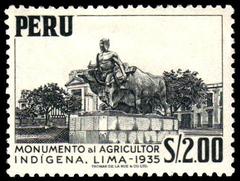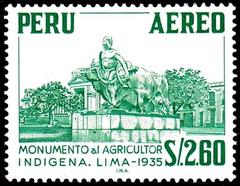
La Yunta Sculpture: Visiting Hours, Tickets, and Guide to Lima’s Iconic Bronze Monument
Date: 15/06/2025
Introduction
La Yunta is not just a monumental bronze sculpture—it’s a cultural touchstone in the heart of Lima, symbolizing Peru’s indigenous heritage and agricultural legacy. Created in 1937 by renowned sculptor Ismael Pozo Velit and gifted by the Chinese-Peruvian community for Lima’s IV Centenary, La Yunta represents the enduring values of rural labor, multiculturalism, and urban identity. This comprehensive guide provides everything you need to plan your visit, from practical details and accessibility tips to historical context and nearby attractions. Whether you’re an art lover, cultural enthusiast, or traveler exploring Lima’s historical sites, La Yunta offers a unique window into the city’s past and present (Wikiwand, Lima Cultura, Kiddle).
Table of Contents
- Introduction
- Origins and Artistic Significance
- Historical and Social Context
- Visiting Information: Hours, Tickets, and Accessibility
- Nearby Attractions
- Visitor Experience: Tips and Etiquette
- Social Impact and Community Role
- Preservation and Future Challenges
- Frequently Asked Questions (FAQ)
- Conclusion
- References
Origins and Artistic Significance
Commissioned in 1937 during Lima’s 400th anniversary celebrations, La Yunta is the work of Ismael Pozo Velit and stands 2.2 meters tall in the Paseo de los Héroes Navales. The sculpture depicts a campesino guiding two yoked oxen, a scene emblematic of Andean agricultural tradition. The name “yunta” refers to the pair of yoked animals and is a metaphor for cooperation and endurance in rural life. La Yunta is a hallmark of the indigenismo movement, which sought to elevate indigenous identity and labor in public art (Wikiwand, Kiddle).
The sculpture’s artistic style blends realism and monumentality, its robust forms conveying both the strength of the animals and the dignity of the farmer. Bronze was chosen for durability and to give the work a timeless quality, ensuring its resilience against Lima’s coastal climate (Lima Cultura).
Historical and Social Context
Indigenous Roots and Urban Development
Before Spanish colonization, Lima was a center for advanced pre-Columbian civilizations such as the Lima, Wari, and Ichma cultures. These societies engineered complex irrigation systems and cultivated the fertile river valleys. With Spanish conquest and the establishment of Lima as the capital of the Viceroyalty, the city became a focal point of political and economic power. Yet, the indigenous legacy persisted, shaping Lima’s evolving identity (World of History).
La Yunta was installed at a time of urban modernization, symbolizing the city’s acknowledgment of its rural and indigenous heritage amidst rapid growth. Its commissioning by the Chinese-Peruvian community further reflects Lima’s longstanding multicultural fabric.
Recognition as Cultural Heritage
On April 24, 2018, La Yunta was declared “Patrimonio Cultural de la Nación” (Cultural Heritage of the Nation) by Peru’s Ministry of Culture, ensuring its protection and highlighting its emblematic role in the collective memory of Lima (Wikiwand, Peru Ministry of Culture).
Visiting Information: Hours, Tickets, and Accessibility
Location
La Yunta is located in the Paseo de los Héroes Navales, central Lima, adjacent to the Palacio de Justicia and within walking distance of Plaza San Martín and the Government Palace (Kiddle).
- Public Transport: The Metropolitano’s Estación Central is steps away.
- Taxis/Rideshare: Readily available throughout Lima.
Visiting Hours
- Open 24/7: As an outdoor public monument, the park is accessible at all times.
- Best times: Daylight hours (morning or late afternoon) are recommended for safety and optimal viewing.
Tickets and Admission
- Admission is free: No tickets or reservations required.
Accessibility
- Wheelchair accessible: The park features paved walkways and ramps.
- Restrooms: Public restrooms are available nearby, though facilities are basic.
Nearby Attractions
Make your visit to La Yunta even more rewarding by exploring these nearby sites:
- Plaza San Martín: Historic square with colonial architecture and monuments.
- Jirón de la Unión: Pedestrian shopping and dining street.
- Museo de Arte de Lima (MALI): Extensive collection of Peruvian art in Parque de la Exposición.
- Parque de la Reserva: Renowned for the Magic Water Circuit.
Visitor Experience: Tips and Etiquette
Photography
- Lighting: Early morning and late afternoon offer the best natural light; Lima’s winter fog (June-August) adds a unique atmosphere.
- Angles: The sculpture’s open setting allows for creative wide-angle shots.
- Respect: Climbing or touching the sculpture is not permitted.
Safety
- Daytime visits: The area is generally safe during the day.
- Personal belongings: Standard precautions apply—keep valuables secure.
Amenities
- Benches and Gardens: Relax and enjoy the landscaped setting.
- Nearby vendors: Snacks, drinks, and souvenirs available from local vendors.
Social Impact and Community Role
La Yunta is a focal point for civic engagement and cultural reflection. Its presence helps foster dialogue between urban and rural communities—especially among Andean migrants in Lima who gather here for cultural celebrations like the annual Día del Campesino (Peasant’s Day), held every June 24th. The sculpture is used in educational programs and community events, reinforcing values of solidarity, perseverance, and respect for ancestral traditions (Peru Info, Lima Easy).
As a backdrop for parades, civic expressions, and artistic performances, La Yunta is woven into the social fabric of Lima, representing both continuity and the evolving nature of Peruvian identity.
Preservation and Future Challenges
La Yunta’s age and exposure to the elements require ongoing conservation efforts. The Municipality of Lima, in partnership with cultural heritage organizations, conducts regular cleaning and restoration to preserve the sculpture’s integrity. As tourism increases, balancing access with preservation is a priority—public awareness and respectful visitation are key (Lima Cultura, Nomadic Matt).
Frequently Asked Questions (FAQ)
Q: Is there an entrance fee to visit La Yunta?
A: No, admission is free and open to the public.
Q: What are the best times to visit?
A: Visit during daylight hours, ideally in the morning or late afternoon.
Q: Is La Yunta wheelchair accessible?
A: Yes, the park has paved walkways and ramps.
Q: Are guided tours available?
A: Many tour operators include La Yunta on walking tours of historic Lima.
Q: Can I take photographs?
A: Yes, photography is allowed and encouraged. Please avoid touching or climbing on the sculpture.
Q: Are there special events at La Yunta?
A: Yes, particularly during Día del Campesino and national holidays when the park hosts cultural and civic celebrations.
Conclusion
La Yunta stands as a powerful symbol of Peru’s agricultural roots, indigenous heritage, and multicultural urban identity. Its central location, free admission, and deep cultural resonance make it an essential stop for anyone exploring Lima’s historical and artistic landscape. Plan your visit during daylight hours, explore nearby attractions, and participate respectfully in the cultural life that surrounds this landmark. For updated information, guided tours, and interactive maps, download the Audiala app and follow us on social media for the latest travel insights.
References and Further Reading
- La Yunta (escultura), 2025, Wikiwand
- La Yunta Cultural Significance and Visitor Information, 2025, Lima Cultura
- La Yunta Sculpture Overview, 2025, Kiddle
- Historical Context of Lima, 2025, World of History
- Peru Ministry of Culture - Cultural Heritage, 2025
- Visitor Tips and Cultural Significance, 2025, Nomadic Matt
- Lima City Guide and Visitor Information, 2025, Lima Easy
- Audiala App for Cultural Tours, 2025
















































































































